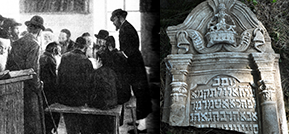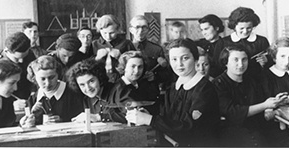
 On July 22nd 2012 a fourth delegation to Galicia, run by the Jewish Galicia Association, commenced. This time the destination was the region of Pokuttya, between the Prut and Cheremosh rivers in southern Galicia. This area was, for hundreds of years, an important intersection between Poland and Romanic and Moldovic lands, and developed a diverse and unique local culture. At the beginning of the 16th century a Jewish community developed and grew in Kolomiya, Pokuttya’s capital, and its surroundings. Additional Jewish communities later developed in other towns in the region and existed there until the Holocaust.
On July 22nd 2012 a fourth delegation to Galicia, run by the Jewish Galicia Association, commenced. This time the destination was the region of Pokuttya, between the Prut and Cheremosh rivers in southern Galicia. This area was, for hundreds of years, an important intersection between Poland and Romanic and Moldovic lands, and developed a diverse and unique local culture. At the beginning of the 16th century a Jewish community developed and grew in Kolomiya, Pokuttya’s capital, and its surroundings. Additional Jewish communities later developed in other towns in the region and existed there until the Holocaust.
The purpose of the Association’s delegation was the documentation of traces of Pokuttya’s Jewish communities, which developed a distinct and unique culture which was later integrated into the general social, cultural and economic life of the entire region.
The delegation was composed of university and yeshiva students from Israel and Russia, including students from the “Siach Yitzchak” Hesder yeshiva, Hebrew University students, Bar Ilan University students, as well as students of Jewish Studies from the St. Petersburg and Moscow state universities. It was guided by Drs. Boris Khaimovich and Ilia Lurie of the Hebrew University, Mrs. Marina Brook of St. Petersburg University and Mrs. Alla Sokolova, a researcher from the St. Petersburg Museum for the History of Religion. An additional member of the delegation leadership was the Israeli documentary cinematographer Mr. Bernard Dichek.
The work of the delegation was carried out in two groups. One group undertook work in the Jewish cemeteries of Yabluniv and Kosiv, and the second worked in Kolomiya. Kolomiya (Kołomyja). the most developed city in Pokuttya at the time, boasted a large Jewish community – on the eve of the Second World War its numbers reached 18,930 (out of a general population of 42,676). This community was culturally vibrant and complex, and its influence on the Jewish culture of Galicia was significant. Before the Holocaust there were approximately 50 operational synagogues in Kolomia, among them the magnificent “Die Hoiche Shul,” a Yerushalaim synagogue, diverse Hassidic kloizes and a Zionist synagogue. One of the central orthodox rabbinic figures of Europe, Rabbi Hillel Lichtenstein, presided as the Rabbi of the city for 23 years (1815-1895). Rabbi Lichtenstein was particularly active in the battle waged between the progressive and orthodox factions over the shaping of modern Judaism during the second half of the 19th century. Jewish political and cultural organizations which developed toward the end of the 19th century enriched communal life, and the city was home to a variety of educational institutions, reflecting a wide array of ideological stances. Between the two World Wars a public library, named after Itzhok Leibush Peretz, operated in the city.

 Kolomiya’s Jews had an important role in the economic development of the region. There were many Jewish businesses in the city: flour mills, beer breweries, banks, tanneries, weaving and prayer shawls factories and brick-making factories, oil refineries and more. Jewish printers published books and other materials, not only for Jews but also for their Christian neighbors – Polish or Ukranian.
Kolomiya’s Jews had an important role in the economic development of the region. There were many Jewish businesses in the city: flour mills, beer breweries, banks, tanneries, weaving and prayer shawls factories and brick-making factories, oil refineries and more. Jewish printers published books and other materials, not only for Jews but also for their Christian neighbors – Polish or Ukranian.
Beginning in the second half of the 19th centuries, Jews took an active part in the communal and political life of the city. Kolomiyan Jews were chosen as representatives for the Galician Sejm and the Vienna Parliament. Jews had respectable representation in municipal government and Jewish representatives were even appointed to mayoral and vice-mayoral positions.
During the Holocaust all of the Jews of Kolomiya and its environs were concentrated in a ghetto comprised of three separate sections. During 1942 these sections were burned and the entire population of the ghetto was destroyed: some were murdered in the city streets, others were taken to the Belzec extermination camp, and the rest were shot in the forest adjoining the village of Sheparivtsy, near the city. Nowadays there are several dozen Jews living in Kolomiya – the descendants of the families who settled in the city after its liberation by the Soviet army.
The purpose of the group working at Kolomiya was the identification and documentation of locations connected to Jewish life in the city. All of the synagogues but five were destroyed during the Holocaust or the period of Soviet rule, and of the three Jewish cemeteries in the city, only empty lots remain. However, the delegation managed to locate buildings which formerly housed different Jewish public institutions: a hospital, an old age home, the Jewish council, a school, a girl’s gymnasium and more. During a tour of the city, members of the delegation also met locals who gave interesting testimonies about the lives of Kolomiya’s Jews. The majority of the group’s findings were presented during a guided tour of the city for the entire delegation.
The adjacent towns of Kosiv (Kosów) and Yabluniv (Jabłonów ) present a different aspect of Jewish culture in Pokkutya. These were small settlements, in which Jews constituted a large majority of the population. Jewish presence in Kosiv is first mentioned in 1635. The town later became famous among Galicia’s Jews as an important Hassidic center: Hassidism took root in the town from its very inception as a movement. Various traditions tie the city to the Ba’al Shem Tov, the founder of the Hassidic movement. From the end of the 18th century until the Second World War the town was home to an important and influential Hassidic dynasty (of the Hager house).
The Jewish cemeteries of Kosiv and Yabluniv survived the War: the oldest tombstones located by the delegation have been dated to the beginning of the 18th century. The Jewish tombstones of these towns are unique witnesses to a particularly rich artistic culture that developed in the region in the 18th and 19th centuries. Stone engravings exemplify a complex symbolic language of images utilized by their creators – the anonymous artists of Jewish Galicia. The walls of a wood synagogue in Yabluniv, which unfortunately did not survive the war, were also decorated in this symbolic language.
The group that worked in Yabluniv and Kosiv documented around 600 tombstones, including all of those from the Yabluniv cemetery and a large portion (around 300) of those from the Kosiv one, which is situated on a steep incline and therefore particularly difficult to access.
Over the course of the delegation a large quantity of material was collected, and this material has been processed and is presented on the Association’s website, thus making an important contribution to the research and commemoration of the historical and cultural legacy of Galicia’s Jews.
To see more photographs of Kolomyia click here






